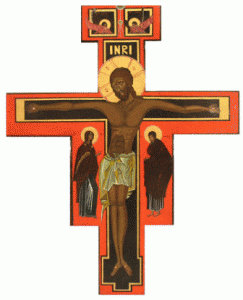 The Cross of Love, Healing and Challenge
The Cross of Love, Healing and Challenge
Often the feast of the Exaltation of the Holy Cross would fall on weekdays. This year it happensto fall on a Sunday, and because it is a Feast of the Lord it takes precedence over the Ordinary Sunday of the Year. It is a feast that is celebrated across the mainline churches, including the Orthodox, Lutheran and Anglican traditions. It commemorates the legend of the finding of the ‘true cross’ by St Helena in 326 AD, and the subsequent dedication of the Church of the Holy Sepulchre in 335. In any case, the feast offers us an opportunity once again to contemplate the mystery of the cross. The cross – “a stumbling block to Jews and folly to Gentiles” (1Cor 1:23) – is the central symbol of our Christian faith. Let us focus on three possible meanings of the cross.
The Cross of Love.
“For God so loved the world that he gave his only Son, so that everyone who believes in him may not perish but may have eternal life” (Jn 3:16). The gospel of text of today captures very succinctly the mystery of the cross in this most cited quotation from the Christian scriptures. There are two ways that Christian doctrine attempts to provide an answer as to why Jesus willingly went to the cross. There is the explanation of expiation – that Jesus, by his own suffering and death, paid the ransom on behalf of humankind to redeem them from the punishment deserved for the disobedience of Adam. Then there is the explanation of love – that Jesus came among us to show how much God loved us, but we rejected him. We refused to accept what he stood for to the extent of putting him to a gruesome death. The first explanation is contained within the second, and I prefer more the latter explanation. It draws me to the cross, because it is not merely a burden of punishment but a symbol of love. It invites me to respond to the love of God made visible in Jesus. It brings healing to my own life that’s marked by suffering.
The Cross that Heals.
“And whenever a serpent bit someone, that person would look at the serpent of bronze and live” (Num 21:9). The people of Israel in the desert refused to accept their human condition – the limitations of that condition. They grumbled against God and Moses, wanting to live a problem-free life. On the other hand, the bite of the serpent reminded them in a harsh manner of their human condition of limitation and suffering. And the healing consisted in looking at the bronze serpent – in embracing the human condition. There was no escape from the serpent. The antidote to poison is poison itself. Embracing suffering is the way to making meaning out of human suffering. This is the lesson emerging from the first reading of today; this is one of the meanings portrayed by the image of Jesus hanging on the cross. As long as I run away from the limitations of my own human condition I remain wounded. I suffer. When I embrace the human limitation I begin the journey towards wholeness. I find meaning in suffering.
The Cross that Challenges Me.
“Have the same mind of Christ” (Phil 2:5). The cross which is a symbol of love and healing also challenges me to a life of love and healing. It challenges me to put on the consciousness of Christ – “who, though he was in the form of God, did not count equality with God a thing to be grasped, but emptied himself, taking the form of a servant, being born in the likeness of men” (Phil 2:6-7). The cross challenges me to empty myself in love to my fellow humans. “If any man would come after me, let him deny himself and take up his cross and follow me” (Mk 8:34). The cross challenges me to mediate healing for humanity. My willingness to embrace the cross is an expression of my readiness for love and healing. And my embrace of the cross – the embrace of my human condition – promises me that I too will be exalted, just as “God has highly exalted him and bestowed on him the name which is above every name.”